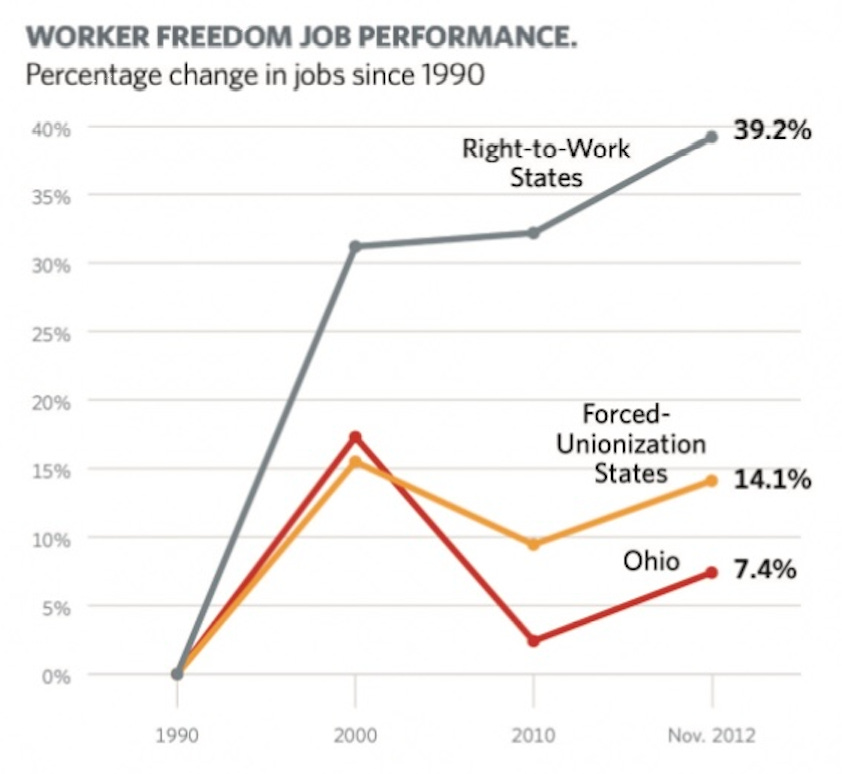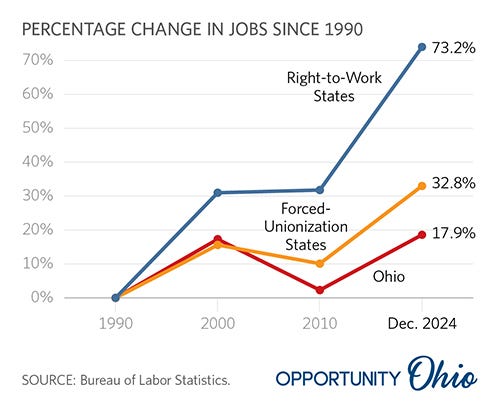The Latest BLS Jobs Data Eviscerate the Talking Points of the DeWine-Husted Administration and JobsOhio
Ohio’s 42nd place ranking after four years destroy the DeWine-Husted Administration’s stewardship of Ohio’s economy and the entire reason for JobsOhio’s existence.
I’ve been at this business a long time. Day-after-day, month-after-month, year-after-year, and, soon, decade-after-decade. I sometimes find it hard to believe I’ve been grinding away at analyzing data, crafting policy solutions, and pushing elected officials to act (or, often times, not to act). With the latest data from the U.S. Bureau of Labor Statistics (BLS) and the creation of the latest monthly one-pagers we produce at Opportunity Ohio, my years of whittling away at this business hit me square between the eyes.
Way back in January 2013, I released on the O2 website the first Ohio Worker Freedom Report. That report evolved over time to the current format, but it contained two charts that we still use today. The first chart shows the percentage change in jobs since 1990 comparing right-to-work states to forced unionization states. We also included the results for Ohio. Back in January 2013, right-to-work states averaged 39.2% net percentage job growth versus just 14.1% for forced unionization states, with Ohio straggling behind at just 7.4%. Twelve years ago, right-to-work states outpaced forced unionization states by 2.74 times, with Ohio 5.3 times less than right-to-work states and just under 1.9 times less than forced unionization states.
Similarly, the second chart showed the data for all fifty states. In January 2013, Ohio stood in the 45th spot ahead of only Massachusetts, New Jersey, Michigan, Rhode Island, and Connecticut. In other words, Ohio, along with pro-union Michigan, joined the dying and heavily unionized New England states in the back of the pack. Back then, spots #37 to #50 were all forced unionization states; meaning, the worst performing states at creating jobs in the private sector WERE ALL FORCED UNIONIZATION states. Right-to-work states dominated the top twenty-five spots (and still do). Michigan was soon to enact right-to-work (reversed in 2024 by Democrats when they took back control of the state).
These two charts are perfect snap-shots of how states had performed over twenty-two years (1990 through 2012). For Ohio, the charts also serve to plant a bright flag by which to measure the then-newly created economic development entity, JobsOhio, and the combined tenure of John Kasich and the Mike DeWine-Jon Husted Administrations. The argument made for creating JobsOhio was that it would revolutionize job creation in Ohio, thereby moving Ohio from the back of the pack where it had wallowed for over a decade to the front of the pack. As Kasich liked to say, JobsOhio would move at the "speed of business, not the speed of a statute.”
Twelve years later, the first chart shows right-to-work states now at 73.2% net percentage job growth, with forced unionization states coming in at 32.8% and Ohio still farther back at 17.9%. For those keeping track, that means right-to-work states more than doubled the output of forced unionization states and quadrupled up on Ohio’s numbers. On the fifty-state comparison, Ohio dropped one spot to 46th, as it bested heavily-unionized Illinois, Vermont, Rhode Island, and Connecticut. Michigan’s brief run as a right-to-work state allowed it to jump past Ohio, as it rose from 48th in 2013 to 44th in 2024 (shame on Michigan Democrats for killing this advance in its infancy). Other than West Virginia, which became a right-to-work state in 2016, every state from 36th to 50th is a forced unionization state.
A new chart we added over the years shows private sector job growth by year and by gubernatorial term. Kasich benefitted from a national recovery from the Great Recession in 2009 that kept America out of a recession until the global pandemic arrived in 2020. Nonetheless, as the Kasich and JobsOhio years wore on, Ohio’s private sector got weaker and weaker, which is exactly opposite of what Kasich promised Ohioans when he created JobsOhio.
Setting aside the pandemic job losses and job recovery, the DeWine-Husted era continued this downward trend in which private sector job growth dribbled in at 32,100 in 2019, 31,800 in 2023, 20,000 in 2024, and -2,800 so far this year. Finally, after the pandemic, we added a new one-pager to track various aspects of Ohio’s recovery, including tracking net percentage job growth of the fifty states and District of Columbia. With the latest BLS revisions, Ohio is ranked 42nd “best” in America. Except for West Virginia, Ohio is the lowest ranked Republican trifecta state (Louisiana only became a trifecta state in 2024 when a Republican won the governor’s office).
To summarize, in the years after JobsOhio was created, Ohio’s private sector got weaker as shown by its drop from 45th in 2013 to 46th in 2024. Likewise, the longer it has done its work, the annual job growth in Ohio has gotten weaker and weaker (that downward arrow). Even using the short-term period following the pandemic, Ohio’s private sector still is among the worst in America. The pandemic shutdown when every state faced the same Biden Administration and global headwinds presented the PERFECT opportunity to prove that the DeWine-Husted Administration policies and the decade of JobsOhio’s spade work were better than whatever was happening in the other states. Ohio’s 42nd place ranking after four years eviscerates both the DeWine-Husted Administration’s stewardship of Ohio’s economy and the entire reason for JobsOhio’s existence.
Let me take a moment to talk about cowardice. For years I have assiduously detailed the systemic weaknesses in the economic policies of Ohio’s elected officials. In most cases, I am the only person on the Right willing to criticize the Right. Others should have raised their voices with me, but chose to stay silent due to cowardice, fear of losing access, or raw political calculations. As they remained silent, Ohio continued to decline and Ohioans suffered. Not once have my analyses been refuted, as would be the case given that I let the data drive my work. They cannot beat me, so they silence me.
Groups such as the Ohio Chamber of Commerce, the Business Roundtable, the National Federation of Independent Businesses, and other trade groups allegedly dedicated to a strong economy and growing private sector also remain irresponsibly silent. They literally fiddle as Ohio burns. Those groups don’t even have the courage to invite me to speak to their members or at events in which my analysis and policy recommendations likely would be welcomed by attendees. Instead, they hear from the same “yes” men and women who parrot the talking points from the DeWine-Husted Administration and JobsOhio. If you belong to any of these groups, demand an answer from the leadership on why they exclude me and my analyses from vital discussions on Ohio’s economy. I would gladly debate anyone, including the head of JobsOhio, on the state of Ohio’s private sector and the long-term failure of JobsOhio to justify its existence and continued funding. Based on the data, Ohio’s results since 2011 compared to the other forty-nine states is abysmal. The results over the last four years are even worse. Perhaps if the Ohio media reported accurately on the “state of the state,” those groups would feel pressured to invite me to address their members.
Even Republican county groups sign up the same, boring elected officials to headline their Reagan-Lincoln Day Dinners who feed attendees the same rubber chicken dinner pablum. Do DeWine, Husted, Kieth Faber, Dave Yost, or Frank LaRose really have anything new to say? If these groups want to serve attendees with red meat, then they should bring in the real deal. If you are on the executive committee, push for a breath of fresh air (Vivek Ramaswamy can’t do EVERY dinner). Elected officials will never change course if their supporters don’t actually hold them accountable for their decades of failure. Stop fawning over titles. Push for change, damn it!!
P.S. In related news, over the first sixty days of the Trump Administration, companies have pledged nearly $3 trillion in new manufacturing investments. Other than possibly taking over the failing Intel project in Ohio, I’m not aware of any of these companies targeting Ohio for this $3 trillion. Interestingly, the LG Energy Solution-Honda project in Fayette County still has not issued any news updates on its website since last November. As of today, there are only twenty-seven job openings at the facility. Such a low number of job openings doesn’t bode well for the project, especially given the Trump Administration’s views on electric vehicles. Is that project headed towards the JobsOhio ashheap of failed projects, too?










